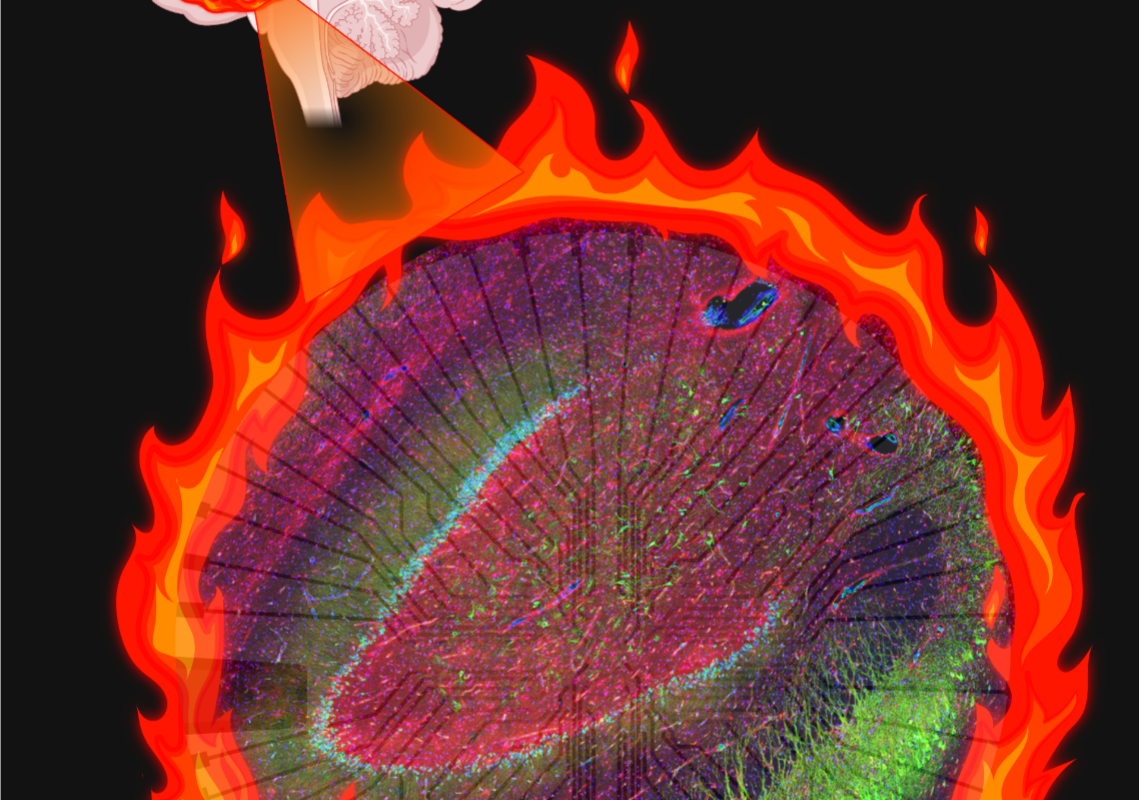Everyone loses some brain cells over time. According to a study headed by researchers from USC Stem Cell and the USC Neurorestoration Center, adults may recover at least some of what they have lost by producing new brain cells, and this process is profoundly modified in patients with long-term epilepsy. The journal Nature Neuroscience published the findings.
 Altered cells create an electrical “fire” in patients with epilepsy. Image Credit: Aswathy Ammothumkandy/Bonaguidi Lab/USC Stem Cell
Altered cells create an electrical “fire” in patients with epilepsy. Image Credit: Aswathy Ammothumkandy/Bonaguidi Lab/USC Stem Cell
Our study is the first to detail the presence of newborn neurons and an immature version of a related cell type, known as astroglia, in patients with epilepsy. Our findings furnish surprising new insights into how immature astroglia might contribute to epilepsy—opening an unexplored avenue toward the development of new anti-seizure medications for millions of people.”
Michael Bonaguidi, Assistant Professor, Stem Cell Biology and Regenerative Medicine, Keck School of Medicine of USC
Bonaguidi also taught in the departments of Gerontology and Biomedical Engineering as an assistant professor. Aswathy Ammothumkandy, a postdoctoral fellow in the Bonaguidi Lab, and her colleagues worked with USC neurosurgeons Charles Liu and Jonathan Russin, who frequently treat patients with seizures that are resistant to the medicine.
Drug resistance is common in people with mesial temporal lobe epilepsy (MTLE), which affects one-third of all patients. As a result, some people will require surgery to remove the hippocampus, the part of the brain that causes seizures.
Many patients bravely and generously donate their surgical specimens for research to advance our understanding of epilepsy and to develop new and better therapies. These patients know better than anyone the trade-offs involved in the current treatment options, which often either don’t provide adequate seizure control or carry very serious cognitive side effects.”
Jonathan Russin, Assistant Professor, Neurological Surgery, Keck School of Medicine of USC
Russin was also an associate director of the USC Neurorestoration Center.
The surgical specimens provided the researchers with an once-in-a-lifetime opportunity to analyze living brain tissue from epilepsy patients and compare its microscopic anatomy to post-mortem samples from those who had no known neurological condition.
The researchers discovered newborn neurons in samples from persons with and without epilepsy, giving strong new evidence to the continuing scientific dispute over whether adults possess the ability to make these cells. The longer the patients endured seizures, the fewer these newborn neurons became in the surgical specimens. Interestingly, the surgical samples had a stable population of immature astroglia that was not present in the disease-free samples.
The scientists were able to develop stem cells in the laboratory and examine their ability to create newborn neurons and immature astrocytes since the brain tissue in the surgical specimens were still alive. Longer disease duration decreased the ability to generate newborn neurons and increased the formation of immature astroglia in these tests, which matched the team’s firsthand findings of surgical material.
The scientists also looked into seizure-related electrical activity. They discovered suspicious links between the location and behavior of the astroglia and where electrical activity was located within the surgical samples.
Normally, astroglia are considered to be supporting cells, because their job is to create an environment where neurons can thrive. But in patients who have lived for many years with epilepsy, it might be immature astroglia that are contributing to both initiating and modulating chronic seizures.”
Aswathy Ammothumkandy, Post-Doctoral Fellow, Bonaguidi Lab, USC Stem Cell
If this is the case, establishing a completely new class of anti-seizure drugs targeting immature astroglia could be a viable option.
Liu, a professor of neurological surgery, neurology, and biomedical engineering, director of the USC Neurorestoration Center, and director of the USC Epilepsy Care Consortium says, “Currently available seizure medications tend to target neurons, so medications that act on immature astroglia could greatly expand the options for our patients.”
“A new class of drugs could combine with current medical and surgical strategies to control seizures without aggressive surgical removal of parts of the brain that can be critically important for learning, memory, and emotional regulation,” Liu added.
Source:
Journal reference:
Ammothumkandy, A., et al. (2022) Altered adult neurogenesis and gliogenesis in patients with mesial temporal lobe epilepsy. Nature Neuroscience. doi.org/10.1038/s41593-022-01044-2.